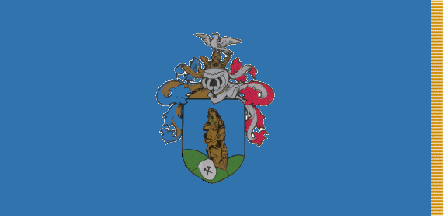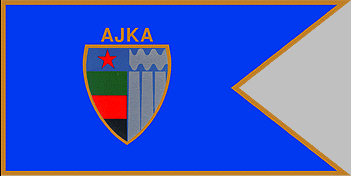 zachary harden
zachary harden
Keywords: hungary | veszprem | ajka | helmet | pigeon | st. barbara | pakn | hammer |
Links: FOTW homepage | search | disclaimer and copyright | write us | mirrors

Last modified: 2023-06-03 by  zachary harden
zachary harden
Keywords: hungary | veszprem | ajka | helmet | pigeon | st. barbara | pakn | hammer |
Links: FOTW homepage |
search |
disclaimer and copyright |
write us |
mirrors

by István Molnár, 26 February 2001
See also:
Ajka is an industrial town in Veszprém County in Hungary on
the western hills of the Bakony Mountains on the Veszprém-Graz
road. The town has got 34.520 inhabitants (1990 census), nearly
all of them are Hungarians. Two of the Official Ethnic Minorities
of Hungary has got ethnic council in the tow: Gipsy and German.
Neighbouring settlements are: Devecser
town, Kolontár, Halimba, Öcs,
Nagyvázsony, Úrkút, Kislöd and Magyarpolány villages.
By a legend Ajka - which settled to the half-basin widened out of
the Little Plain -, is located on the territory, where the giant
stumbled over the Somló Hill struck his lips. (lip in Hungarian
'ajak', 'his lip' in Hungarian 'AJKA')
The first mention of the settlement is from 1214. It was
devastated at the time of the Turkish Wars (1552 and 1683). Later
resettled with Hungarians. The beginning of coal mining was in
the 19th century. Ajka became an industrial settlement. In the
1930s there bauxite found.
In 1910 in the territory of nowadays Ajka were 8 villages in the
Devecser district of Veszprém County of the Kingdom of Hungary.
Number of their inhabitants in 1910: Ajka (2.862, 76% Hungarian,
21% German), Ajkarendek (945, 92% German), Bakonygyepes (318, 70%
German, 30% Hungarian), Bódé (609, 98% Hungarian), Csékút
(586, 100% Hungarian), Padrag (740, 100% Hungarian), Tósok
(570, 100% Hungarian), Tósokberénd (655, 77% German, 23%
Hungarian).
In 1950 Tósok was united with Tósokberénd. In 1959 Bódé and
Tósokberénd were united with Ajka. On 1st November 1959 Ajka
became a town. In 1961 Padrag and Csékút were united as
Padragkút. In 1971 Ajka became the seat of the Devecser
district. In 1977 Ajkarendek and Bakonygyepes were united with
Ajka and in 1984 Padragkút was united with Ajka. Partner
settlements: Rovaniemi (Finland), Székelykeresztúr (Rumania),
Unna (Germany) and Weiz (Austria)
The coat of arms and the flag were adopted in 1992 by the Resolution No.
24/1992 (IX. 28.). The settlement has got a coat of arms, a decorated coat of
arms,
a flag and a ceremonial flag (flag with gold fringes)
Description of the Coat of Arms (2§ of the resolution): Blue
standing shield with pointed bottom. In the shield Virgin St.
Barbara martyr stands on a green triplicate hill. In her right
hand there is a green palm branch. Before her legs there is a
little gold shield, in the shield there are two black hammer. The
symbols relate to the mining. Decorated coat of arms . On the blue shield
there is a helmet with white pigeon. This decoration is the same
of the decoration of the shield of the formerly Ajka Clan.
István Molnár, 12 March 2001

by Sandor Kiss (HMKS)
, 28 August 1999
"The coat of arms of the town is a dark blue divided shield. In
the left side under the red star there are three stripes. The
green relates to the forested surroundings, the red relates to
the bauxite, the black relates to the coal mines. In the right
side three silver chimney-stacks reaching to the high relate to
the aluminium industry of the town."
Source: A magyar városok címerei (coats of arms of the
Hungarian cities and towns); 1975
István Molnár, 17 December 2000
Large
ajka1.gif)
by István Molnár, 12 March 2001
Small
ajka.gif)
by István Molnár, 12 March 2001